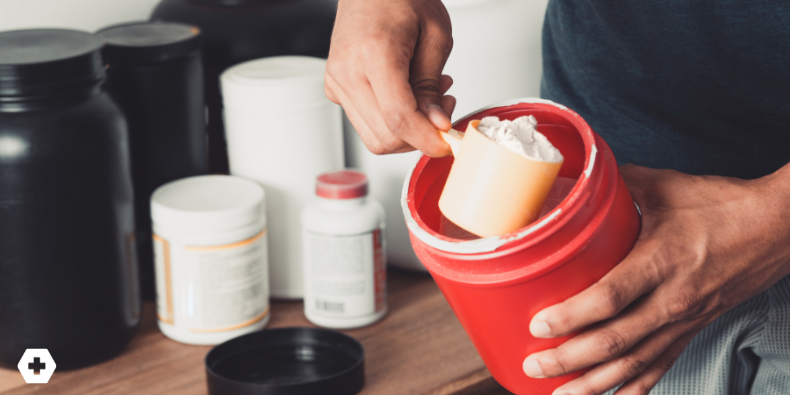
Integrative Medicine: Creatine: Miracle Muscle Booster or Just Hype?

Creatine has come a long way from being a supplement for bodybuilders and elite athletes. Today, it’s generating buzz in women’s health, aging, and even brain health. Patients are asking about it, and the research is catching up. So, is creatine really worth the hype? Let’s break down what we know, what’s still unclear, and how you can guide your patients.
What Is Creatine?
Creatine is a naturally occurring compound stored in muscles, where it plays a pivotal role in energy production. Technically speaking, creatine (N-aminoiminomethyl-N-methyl glycine) is a metabolite derived from three amino acids: arginine, glycine, and methionine. Our bodies produce it mainly in the kidneys, pancreas, and liver, while the rest comes from dietary sources, mainly red meat and fish.
Here’s an interesting tidbit: 95% of creatine is stored in our muscles, and only 5% can be found in other tissues like the heart and brain. Creatine’s primary job in the body is to replenish ATP (adenosine triphosphate), which is essential for cellular energy and muscle contractions. Essentially, it helps fuel high-intensity exercise and supports muscle function.
Why Supplement Creatine? Isn’t Diet Enough?
The average person consumes about 1.38 grams of creatine per day, based on NHANES data, but depending on diet and activity levels, they may need more. For instance, vegetarians and those who don’t eat red meat or fish may have 30% lower creatine stores than omnivores, putting them at a disadvantage in terms of energy production in the muscles.
A daily intake of 2-3 grams would suffice for most people, but active individuals (particularly those with higher muscle mass) may need more. That’s where creatine supplementation can step in, providing a quick and effective way to boost stores for those who aren't getting enough from food.
Forms of Creatine and Dosage
The most common and well-studied form of creatine is creatine monohydrate, typically found in powder form, which can be mixed with water or a post-workout shake. Some companies make drinks with creatine in them (usually a “post-workout” type of drink), but it’s unclear how stable the creatine is when kept in a liquid formulation. Other forms of creatine are available, but these haven’t been studied to the same extent, so creatine monohydrate is still considered the gold standard.
The recommended dose is 3-5 grams per day (about 0.1 grams per kilogram of body mass). There’s some debate about the need for a "loading phase," where higher doses are taken initially, but evidence shows that regular, consistent dosing is more important than timing around workouts. As always, when recommending any supplement, it’s crucial to remind patients that creatine supplements are not FDA-regulated. It’s best to look for brands with third-party testing and certifications like Good Manufacturing Practice (GMP) or USP-verified to ensure safety and quality.
What Does the Research Say? Top Evidence Based Benefits
- Athletic Performance
The most well-established benefit of creatine supplementation is enhanced performance in high-intensity exercise. Creatine has been shown to improve strength, power output, and recovery when combined with resistance training. It’s particularly beneficial for activities like weightlifting, HIIT, and sprinting. However, it doesn’t appear to help with aerobic exercises like long-distance running. As the International Society of Sports Nutrition puts it, creatine is “the most effective ergogenic supplement for athletes aiming to increase high-intensity exercise capacity and lean body mass.”
- Muscle Preservation in Older Adults
Muscle loss due to aging, known as sarcopenia, is a major concern for older adults. As we age, we naturally lose muscle size and strength, which can impact mobility, balance, and overall quality of life. Early research suggests that when combined with resistance training, creatine supplementation can help preserve muscle mass and improve muscle strength in older adults. However, creatine alone isn’t effective in preventing sarcopenia—exercise is key.
- Women’s Health: Perimenopause and Menopause
Creatine is also gaining attention in women’s health, particularly for those navigating perimenopause and menopause. Research suggests that creatine may help increase muscle mass and enhance strength in postmenopausal women, who often experience a decrease in muscle mass due to hormonal changes. While creatine hasn’t been shown to significantly impact bone density or bone turnover markers, its role in muscle preservation could be beneficial for overall functional health.
- Cognitive Health
Creatine is not just for muscles—it’s also being researched for its potential role in brain health. Since the brain also stores creatine, supplementation might offer benefits for conditions like neurodegenerative diseases, traumatic brain injury (TBI), depression, and anxiety. While early data is promising, the evidence is still lacking in terms of the exact dosage required and the extent of its cognitive benefits.
Are There Any Risks?
Creatine is generally considered safe for most healthy adults with normal kidney function. Concerns around creatine often revolve around potential kidney damage, hair loss, dehydration, and muscle cramping. Although creatine supplementation can lead to an increase in serum creatinine (which is a marker of kidney function), this doesn’t necessarily indicate kidney damage.
Creatine breaks down into creatinine, which is excreted in urine, but there’s no solid evidence linking creatine to decreased kidney function in healthy individuals. However, caution is advised in patients with chronic kidney disease (CKD) or those with a single kidney, as creatine could potentially affect kidney function in these individuals. There’s also no strong evidence to suggest that creatine causes hair loss, muscle cramping, or dehydration, which are not common side effects if the supplement is used correctly.
What About Kids, Teens, or Pregnant People?
The International Society of Sports Nutrition considers creatine supplementation likely safe for competitive young athletes (under professional supervision and proper training). However, it is not recommended for children under 18 unless they are seriously engaged in competitive training. As with all supplements, it’s essential to ensure that younger athletes use creatine responsibly and do not exceed recommended dosages.
There are no human trials on creatine supplementation in pregnant and breastfeeding people, so it’s not recommended at this point.
Creatine Takeaways for Clinical Practice
When discussing creatine with patients, focus on these key points:
1. Primary Benefit: Creatine’s biggest benefit is muscle strength and function, especially when used in combination with resistance training or high-intensity exercise.
2. Safety: Creatine is safe for healthy adults with normal kidney function. However, it should be used cautiously with patients with kidney disease or renal issues.
3. Use in Women’s Health: Creatine can be beneficial for postmenopausal women, particularly for increasing muscle mass and strength. However, its effects on bone health are still unclear.
4. Supplement Choice: Creatine monohydrate in powder form (3-5 grams/day) is the most studied and safest option. Look for products that are third-party tested and have GMP or USP-verified marks.Creatine is no longer just for bodybuilders. It’s emerging as a versatile, evidence-based supplement that can benefit performance, muscle preservation, and, potentially, brain health.
Before recommending creatine, assess patients’ activity levels, dietary habits, and goals. Remind them that creatine works best when paired with strength training. It’s not a magic bullet, but for the right patients, it’s an effective and safe tool for supporting their overall health.
This content includes material generated by ChatGPT to aid in the editing process. All material has been human-reviewed and approved by our content team.
Practice-Changing Education
Experience education that goes beyond theory. Explore Hippo Education’s offerings below.


